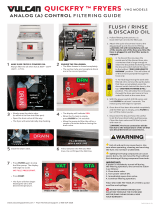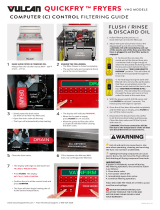
NOTE
Do not leave the fryer unattended during cleaning. Never let the water level go below
the "Min Level" mark on the back of the tank.
e. Using the fryer cleaning brush, scrub the inside of the fryer to remove protective coating.
f. When cleaning is complete, Press the OFF side of the OFF-ON-START switch to turn the fryer
off. Drain the water into a container suitable for hot water and dispose of it.
g. When the tank has cooled, rinse it thoroughly with cool water. Continue to rinse the tank until
the cleaner has been rinsed thoroughly from the tank.
h. Using a clean dry cloth, wipe out all of the water. Be sure to completely remove all water,
because any residual water will cause hot oil to splatter out of the fryer.
CAUTION
Fryers with mild steel tanks must be wiped down and coated with oil to keep the tank
from rusting. This must be done if the fryer is not going to be used immediately.
i. Now that the tank is clean, you are ready to fill and operate the fryer. Refer to 2.1 for
instructions on adding shortening to the fryer.
1.5.3 Thermostat Calibration Check - Backup Thermostat Only
The temperature settings on the thermostat knob must match the actual temperature in the fryer for proper
control of the produce being cooked. Fill the fryer with oil as described in 2.1.
a. Press the START side of the OFF-ON-START switch and release. The switch will snap back
to the ON position. Allow the computer to bring the fryer to normal operating temperature.
b. Let the fryer cycle 4 to 6 times before checking the temperature. Open the front door of the fryer
to gain access to the backup thermostat.
c. Slowly turn the thermostat knob and listen for the thermostat to click. You can also feel the
thermostat when it clicks. Although the thermostat is not controlling the fryer, its temperature
probe is still sensing the temperature of the fryer.
d. When the thermostat clicks, compare the setting on the knob to the temperature reading of the
computer. If the temperature on the thermostat is within 5°F of the computer reading, the
thermostat is calibrated. If the thermostat dial is more than 5°F away from the computer reading,
go to step e.
1-11
























